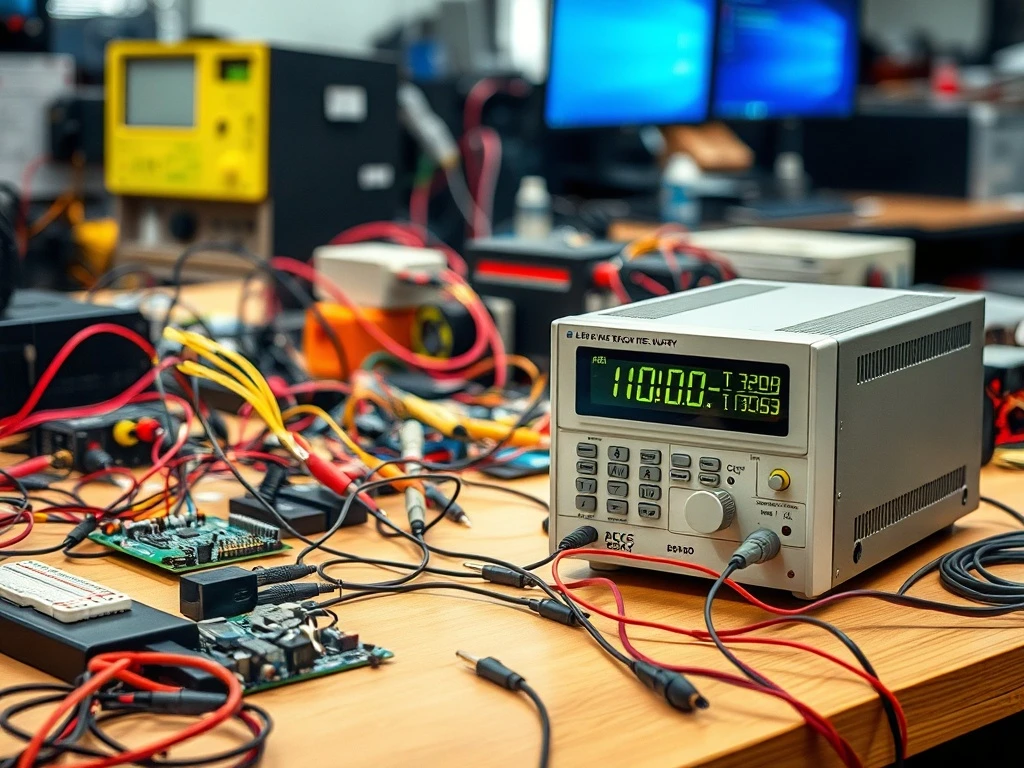For anyone immersed in the world of electronics, a reliable bench power supply stands as an indispensable tool. Whether you are building circuits from the ground up or meticulously testing individual components, this device provides the essential power needed for experimentation and analysis. Moreover, selecting the appropriate bench power supply can significantly enhance efficiency, prevent costly mishaps, and deliver the precision required for accurate work. Navigating the vast array of available models can feel overwhelming. Therefore, this guide offers a clear pathway to narrow down your options, ensuring you choose the best unit for your projects and future endeavors.
Understanding Your Core Needs: Voltage and Current Requirements for a Bench Power Supply
Your first and most critical step involves clearly defining your voltage and current requirements. If you are working with test equipment or complex circuits, you must know the precise power demands of each component. Overestimating these values could lead to wasted resources. Conversely, underestimating them can result in instability or even permanent damage to your valuable equipment.
A power supply offering variable voltage and current is generally ideal. Firstly, consider the highest voltage and current your most demanding project will require. For instance, if you are working with higher-powered devices, such as motors or industrial systems, you will undoubtedly need a supply capable of providing higher currents or voltages. Ultimately, select a model that offers ample flexibility to adjust these settings. This ensures you can accommodate a wide variety of future projects without needing a new unit.
- Voltage Range: Determine the maximum voltage your projects will need.
- Current Capacity: Identify the peak current draw of your circuits.
- Adjustability: Look for fine-grain control over both voltage and current.
Prioritizing Output Quality: Ripple, Noise, and Regulation in Your Bench Power Supply
A stable and clean output is absolutely crucial for the proper functioning of your projects. This is especially true when testing sensitive circuits. Poor-quality power supplies can introduce unwanted noise or significant voltage fluctuations. Consequently, these issues lead to inaccurate measurements or, worse, cause malfunctions in your delicate devices. Therefore, always look for a bench power supply that offers excellent regulation and low ripple.
Regulation refers to how effectively the output voltage remains steady under varying load conditions. Meanwhile, ripple measures unwanted variations in the output voltage, typically AC components superimposed on the DC output. A high-quality bench power supply will keep these undesirable elements to an absolute minimum. This ensures a smooth and reliable output that will not interfere with your critical tests. Furthermore, if your work involves particularly delicate components, such as analog devices or precision circuits, investing in a supply with exceptionally low ripple is highly advisable.
Ensuring Safety: Critical Protection Features for Your Bench Power Supply
Safety should never be overlooked when working with electrical equipment. Always look for models that incorporate robust, built-in protections. These include features like overcurrent protection (OCP), overvoltage protection (OVP), and thermal shutdown (OTP). These critical features safeguard both your bench power supply and your valuable projects. They prevent damage from unexpected surges, short circuits, or internal faults. Additionally, some units offer reverse polarity protection, which guards against incorrect connections.
It is also vital to consider the ease of monitoring and controlling the output. A clear display showing real-time data such as voltage, current, and power can be invaluable. This allows for quickly identifying any problems or discrepancies. Moreover, ensure the supply has a reliable and easy-to-access shutdown feature. This is crucial for emergencies, allowing immediate power cutoff.
Choosing the Right Type: Linear vs. Switching Bench Power Supplies
When selecting a bench power supply, you will encounter two primary types: linear and switching. Each type has distinct characteristics that make it suitable for different applications. Understanding these differences is key to making an informed decision.
- Linear Power Supplies:
- Pros: Offer extremely low noise and ripple, excellent regulation, and fast transient response. They are ideal for sensitive analog circuits, audio applications, and precision measurements.
- Cons: Generally larger, heavier, and less efficient due to heat dissipation. They can also be more expensive for higher power outputs.
- Switching Power Supplies:
- Pros: Much smaller, lighter, and significantly more efficient. They can deliver higher power outputs in a compact form factor.
- Cons: Typically produce more ripple and noise compared to linear supplies. This can be an issue for very sensitive applications. However, modern switching supplies have improved greatly in this regard.
For most general electronics work, a high-quality switching bench power supply is often sufficient. However, for specialized tasks requiring absolute minimal noise, a linear supply remains the superior choice.
Optimizing for Versatility: Single vs. Multiple Outputs on Your Bench Power Supply
Many projects require more than one voltage rail. In such cases, a bench power supply with multiple outputs can be incredibly beneficial. Single-output units are simpler and often more affordable. However, they necessitate external wiring or additional supplies if your project demands multiple voltages (e.g., +5V, +12V, -12V). Consequently, a multi-output unit streamlines your setup significantly.
Look for features like independent control for each output. Furthermore, some advanced models offer ‘tracking’ capabilities. This allows one output to follow another, maintaining a fixed voltage ratio. For example, a +15V/-15V tracking supply is invaluable for operational amplifier circuits. Consider your typical project complexity. If you frequently work with circuits requiring multiple voltage levels, a multi-output bench power supply will undoubtedly enhance your efficiency and reduce clutter on your workbench.
Enhancing User Experience: Display and Interface for Your Bench Power Supply
The user interface of a bench power supply plays a significant role in its usability. Firstly, consider the display type. Digital displays offer precise readings of voltage and current, which is essential for accurate work. Some advanced units also show power consumption. Conversely, older or simpler models might use analog meters, which are less precise but can offer a quick visual indication of changes.
Beyond the display, evaluate the controls. Are the knobs smooth and responsive? Do they allow for fine adjustments, or are they coarse? Precision multi-turn potentiometers are excellent for fine-tuning voltage and current. Furthermore, some modern supplies feature numerical keypads or rotary encoders for setting values. Ultimately, an intuitive interface reduces setup time and minimizes errors, making your overall experience much more pleasant and productive.
Future-Proofing Your Investment: Programmability and Connectivity for a Bench Power Supply
A bench power supply is an investment. Therefore, you want to ensure it will serve you well over time. Consider future-proofing your purchase by selecting a model that offers room to grow with your evolving needs. This might mean choosing a unit with higher power capabilities than your current project demands. Alternatively, opt for a model that includes additional features like programmable settings or remote control options.
Many modern power supplies offer connectivity options such as USB, GPIB, or Ethernet. These allow for remote control via a computer, enabling automated testing sequences and data logging. This feature is invaluable for repetitive tests, long-term experiments, or integration into automated test setups. Moreover, consider the quality of the brand. Well-established manufacturers tend to offer better durability and support. They often provide firmware updates or easily accessible replacement parts. This ensures your equipment doesn’t become obsolete too soon. Investing in a higher-quality, slightly more expensive model may save you from needing to replace it as your projects scale up and become more sophisticated.
Considering Practicality: Form Factor and Budget for Your Bench Power Supply
Finally, practical considerations like form factor and budget are important. Bench power supply units come in various sizes and weights. If your workspace is limited, a compact model is essential. If you frequently transport your equipment, portability becomes a key factor. Some units are designed to be stackable, saving valuable bench space. Others are rack-mountable for professional lab environments.
Budget, naturally, is a significant constraint for many. While it’s tempting to opt for the cheapest option, remember the adage: you get what you pay for. A very inexpensive bench power supply might lack crucial safety features, offer poor regulation, or simply not last. Balance your budget with your needs, prioritizing safety and output quality above all else. Sometimes, a slightly higher initial investment pays dividends in reliability, precision, and longevity, preventing future frustration and unexpected costs.
Choosing the right bench power supply is a decision that significantly impacts your electronics projects. By carefully assessing your power requirements, prioritizing output quality and safety features, and considering the type, versatility, and long-term viability of the unit, you can make an informed choice. Ultimately, a well-chosen power supply will be a cornerstone of your workbench, empowering your creativity and ensuring the success of your electronic endeavors for years to come.
Frequently Asked Questions (FAQs) About Bench Power Supplies
Q1: What is the primary difference between a linear and a switching bench power supply?
Linear power supplies offer very low noise and ripple, making them ideal for sensitive analog circuits, but they are typically larger, heavier, and less efficient. Switching power supplies are smaller, lighter, and more efficient, suitable for most general applications, though they might have slightly higher noise levels.
Q2: Why is low ripple important for a bench power supply?
Low ripple ensures a very stable and clean DC output voltage. High ripple can introduce unwanted AC components into your circuit, leading to inaccurate measurements, instability, or even damage to sensitive electronic components, especially in precision analog or RF applications.
Q3: What safety features should I look for in a bench power supply?
Essential safety features include Overcurrent Protection (OCP), Overvoltage Protection (OVP), and Thermal Shutdown (OTP). Some units also offer short-circuit protection and reverse polarity protection, which are crucial for safeguarding both the supply and your connected circuits.
Q4: Should I choose a single-output or multi-output bench power supply?
Choose a multi-output supply if your projects frequently require multiple voltage rails (e.g., +5V, +12V, -12V) simultaneously. A single-output unit is sufficient if you only ever need one voltage at a time, or if you plan to use multiple individual supplies for different voltages.
Q5: How do I determine the voltage and current capacity I need for my bench power supply?
Identify the maximum voltage and peak current draw of the most demanding circuit or component you plan to power. It’s often wise to choose a supply with a slightly higher capacity than your immediate needs to allow for future projects and unexpected current spikes.
Q6: Can a bench power supply be used to charge batteries?
While a bench power supply can provide the necessary voltage and current, it’s generally not recommended for direct battery charging without additional circuitry. Dedicated battery chargers incorporate specific charging profiles (e.g., constant current, constant voltage stages) and safety mechanisms that a standard bench power supply lacks, which are essential for safe and efficient battery charging.






















